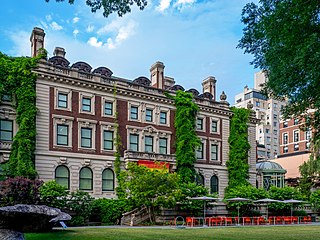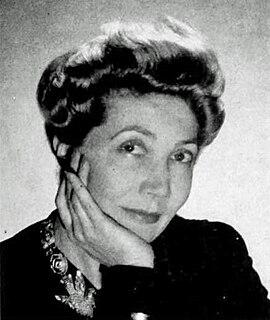Related Research Articles

Cooper Hewitt, Smithsonian Design Museum is a design museum located in the Upper East Side's Museum Mile in Manhattan, New York City. It is one of 19 museums that fall under the wing of the Smithsonian Institution and is one of three Smithsonian facilities located in New York City, the other two being the George Gustav Heye Center in Bowling Green and the Archives of American Art New York Research Center in the Flatiron District. It is the only museum in the United States devoted to historical and contemporary design. Its collections and exhibitions explore approximately 240 years of design aesthetic and creativity.
Mary Walker Phillips was an American textile artist, author and teacher. She revolutionized the craft of hand knitting by exploring knitting as an independent art form. In the catalog to her 1984 Fresno Arts Center exhibition, Jack Lenor Larsen described Mary Walker Phillips as the "transition between the old-fashioned, pattern-book knitting and the extraordinary things going on in England and America today." Her hand knit tapestries and other creative pieces are exhibited in museums in the U.S. and Europe.

Isabel Toledo was a Cuban-American fashion designer based in New York City.
Rodarte is an American brand of clothing and accessories founded and headquartered in Los Angeles, California by sisters Kate and Laura Mulleavy.

Edward McKnight Kauffer was an American artist and graphic designer who lived for much of his life in the United Kingdom. He worked mainly in poster art, but was also active as a painter, book illustrator and theatre designer.

Dorothy Wright Liebes was an American textile designer and weaver renowned for her innovative, custom-designed modern fabrics for architects and interior designers. She was known as "the mother of modern weaving".

Lockwood de Forest was an American painter, interior designer and furniture designer. A key figure in the Aesthetic Movement, he introduced the East Indian craft revival to Gilded Age America.

Trude Guermonprez (9 November 1910–8 May 1976, born Gertrud Jalowetz, was a German born American textile artist and designer known for her tapestry landscapes. Her Bauhaus-influenced disciplined abstraction for hand woven textiles greatly contributed to the American craft and fiber art movements of the 1950s, 60s and even into the 70s, particularly during her tenure at the California College of Arts and Crafts.
Alfons Bach (1904–1999) was a German industrial designer and watercolor painter. He is known for his architectural design projects and his tubular steel furniture, which have been described as "icons for their period."

Felice "Lizzie" Rix-Ueno (1893–1967) was an Austrian textile, wallpaper, and craft designer. She lived in Japan, and became an influential figure in the Japanese modern art scene.
Cynthia Schira is an American textile artist and former university professor. Her work is represented in the collections of many major public museums.
Maria Monaci Gallenga (1880–1944) was an Italian textile designer and fashion designer. Along with her husband, Gallenga invented a unique metallic, block printing technique for fabrics that gave her textiles a distinct hue.
Marianne Strengell was an influential Finnish-American Modernist textile designer in the twentieth century. Strengell was a professor at Cranbrook Academy of Art from 1937 to 1942, and served as department head from 1942 to 1962. She was able to translate hand-woven patterns for mechanized production, and pioneered the use of synthetic fibers.

Helena Hernmarck is a Swedish tapestry artist who lives and works in the United States. She is best known for her monumental tapestries designed for architectural settings.

Sarah Hewitt and Eleanor Hewitt, also known as The Hewitt Sisters, were American art advocates and founders of what is today the Cooper Hewitt, Smithsonian Design Museum in New York City. They are the granddaughters of Peter Cooper, an American industrialist, inventor, philanthropist, and founder of the Cooper Union for the Advancement of Science and Art. The sisters first established the museum on the fourth floor of the Cooper Union. They sought to foster American design and appreciation for the decorative arts.

Pola Stout was an American designer best known for creating fine woolen fabrics. Born in Stryj, she studied with Josef Hoffmann at the Kunstgewerbe Schule in Vienna, and designed for the Wiener Werkstätte before she immigrated to the United States in 1925 with her first husband, architect and designer Wolfgang Hoffmann. Wolfgang and Pola Hoffmann became a prominent interior design team that contributed to the development of American modernism in the early 20th century. They dissolved their successful partnership in 1932, when she married popular mystery author Rex Stout. Pola Stout was an influential textile designer after her second marriage.
Softseating fanning stool + bench is a furnishing made from paper or textile, designed by Stephanie Forsythe and Todd MacAllen of molo in 2003 and released in 2006. Internal honeycomb geometry allows the elements to store compressed, and then fan open to form seats and tables. Examples of softseating are held in the Museum of Modern Art, the Art Institute of Chicago and the Cooper Hewitt, Smithsonian Design Museum.
Nell Znamierowski is an American textile artist.
Ethel Stein (1917–2018) was an American textile artist who lived in Croton-on-Hudson, N.Y. While her work was primarily in weaving, her best known piece is the puppet Lamb Chop.
Tammis Keefe was an American textile designer.
References
- ↑ Lesley Jackson (8 February 2007). Twentieth Century Pattern Design. Princeton Architectural Press. pp. 110–111. ISBN 978-1-56898-712-5 . Retrieved 12 October 2012.
- ↑ Elenhank | People | Collection of Smithsonian Cooper-Hewitt, National Design Museum
- ↑ The Metropolitan Museum of Art - Search the Collections
- ↑ Kluck, Eleanor | The Art Institute of Chicago
| This textile arts article is a stub. You can help Wikipedia by expanding it. |
